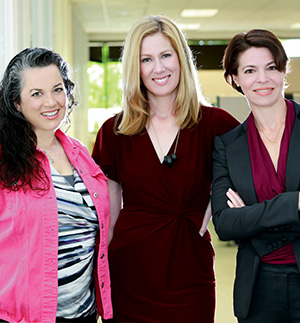Features & Columns
BlogHer Female Global Network
global network, enabling voices to be heard—and rewarded
 Elisa Camahort Page, Lisa Stone and Jory Des Jardins formed a tight team that steered BlogHer through a decade of growth.
Elisa Camahort Page, Lisa Stone and Jory Des Jardins formed a tight team that steered BlogHer through a decade of growth.
A decade ago, in the ancient age of stammering dial-up, when the term "blog" was truncated geekspeak for "weblog" and familiar to only a small fraction of Internet users, most bloggers were men. For all its promise of disrupting the status quo, the fledgling World Wide Web already reflected the underrepresentation of female voices in traditional media.
"They were creating a new old-boys club," says Elisa Camahort Page, who began to dabble in social networks around that time, back when they were still called "online communities." "There was this prevailing narrative that women didn't really want to blog, that they weren't as interested in politics. Everywhere, on TV, online, in articles, you heard, 'Where are the women?' It was after the 2004 presidential election and there was this ongoing discussion about the lack of women pundits on talk shows, women sources in newspapers, women in tech and women who blog."
The San Jose State University theater major had ventured into technology by way of her interest in digital video, landing a job with Harmonic Lightwave, a manufacturer of fiber optic transmitters. Her next job ended after more than three years, when she took a voluntary layoff package from Terayon Communications Systems in the dark days following the dotcom crash and exited with some money in the bank.
"During the bust, I sort of walked away from the corporate job I had and my very nice salary and my very nice title," Camahort says. "I was burned out and didn't want to be in that industry anymore."
What started as a conference of female bloggers in 2005 evolved into a network that reaches an audience of 100 million a month and pays millions of dollars to monetize blogs and microblogs on virtually every major social platform. She teamed up with author Jory Des Jardins and ex-CNN journalist Lisa Stone, who'd started her journalism career in the early 1990s at Metro, to create the summit. It became the foundation for a company that exploded into an online media powerhouse.
"No one's asking 'Where are the women who blog?' anymore," says Camahort, who's celebrating a decade in the professional blogosphere with the 10th annual BlogHer conference in San Jose next month. By recent counts, most blogs are run by women and one-in-three by moms. "The demographics have definitely shifted in our favor."
Still, the question remains: "Where are the women in tech?"
Google reminded the world of the industry's dismal diversity numbers when it released its workforce demographics earlier this month: 30 percent women, 70 percent men. Part of the focus at the decennial anniversary of the BlogHer event will address that discrepancy.
"For a lot of women, blogging is the gateway drug to tech," Camahort says. "But more than that, it's a way to claim ownership and a way to get involved in entrepreneurship, which spans any industry."
Camahort, who just turned 50, considers herself well into her fourth career. She's big on reinvention.
"Every five years you should be doing something different," she says over a cappuccino at Bellano Coffee in Santa Clara. "You reset the table," she knocks imaginary dishes onto the floor with a sweep of her arm.
While blogging about politics -- including the 2004 Democratic National Convention in Los Angeles -- former eBay executive Steve Westly's speech resonated with her. Stone covered the DNC too, blogging for the Los Angeles Times, when Westly explained how eBay created livelihoods for many people.
"The audience didn't feel his message but it really resonated with me," she recalls. "I was already messing around with these online communities and had what I call my peanut butter-and-chocolate moment. I figured that blogging would be such a great communication tool for companies and personal uses. If it could help me, it could help other women. We could monetize it."
During the recession in 2008, the message of self-sufficiency took on greater meaning for BlogHer. A few hundred bucks a month in ad revenue "was a lifeline" for many of their bloggers. The platform gave people a chance to make money off of what they create. (Camahort herself made a few extra dollars in the late aughts selling her posts about vegan dining to Metro for the "Silicon Veggie" column.)
More than providing advertising rev-shares, BlogHer became a platform for writers to boost a personal brand, land speaking engagements, pitch products, widen professional networks and catch freelance consulting gigs. Several BlogHer members crossed over to traditional publishing. "The Blogess" Jenny Lawson wrote a book, Let's Pretend This Never Happened (A Mostly True Memoir), that became a New York Times bestseller in 2012. Lawson is set to speak at this summer's conference... continue reading


